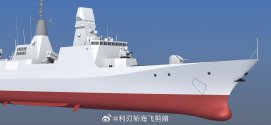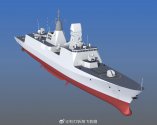You are using an out of date browser. It may not display this or other websites correctly.
You should upgrade or use an alternative browser.
You should upgrade or use an alternative browser.
054B/new generation frigate
- Thread starter Blitzo
- Start date
The small rectangle just beneath the radar but above the IFF strip. I think that's the CEC or datalink.
I still think there will be a second radar in the second mast near the funnel just like the 054A. It's PLAN architectural doctrine to have a secondary surface search radar namely intended for sea skimming antiship missiles.
I still think there will be a second radar in the second mast near the funnel just like the 054A. It's PLAN architectural doctrine to have a secondary surface search radar namely intended for sea skimming antiship missiles.
Would the CEC or datalink antennas be affected by being on the rotating part of the dome? USG-2 are on fixed arrays and I am not sure if USG-3B on the E-2 is rotating or fixed.The small rectangle just beneath the radar but above the IFF strip. I think that's the CEC or datalink.
I still think there will be a second radar in the second mast near the funnel just like the 054A. It's PLAN architectural doctrine to have a secondary surface search radar namely intended for sea skimming antiship missiles.
Would the CEC or datalink antennas be affected by being on the rotating part of the dome? USG-2 are on fixed arrays and I am not sure if USG-3B on the E-2 is rotating or fixed.
The beams on the CEC arrays could be contrarotating to stay on a fixed destination/source, which is another matching array. It can also be that the radar has stationary or 'glare' or 'stare' modes, where it keeps it's face fixed in one direction. Given the way it's shaped the radar may have a 'home' or 'default' position where it stares forward. The array is capable of both horizontal and vertical electronic scan under different modes but can operate on a traditional search mode of vertical scan only with mechanical rotating horizontal scan.
While we can prioritize the radar to be as high as possible for the greatest extent of radar horizon, CEC antennas must be the next to be set as high as possible to allow the ships as far over the radar horizon to communicate with each other. The higher the array location the farther the ships can directly communicate with a beam on a straight line of sight.
I see. Could be installed on aft mast on top of the quick response radar tho if it is better to be fixed right.The beams on the CEC arrays could be contrarotating to stay on a fixed destination/source, which is another matching array. It can also be that the radar has stationary or 'glare' or 'stare' modes, where it keeps it's face fixed in one direction. Given the way it's shaped the radar may have a 'home' or 'default' position where it stares forward. The array is capable of both horizontal and vertical electronic scan under different modes but can operate on a traditional search mode of vertical scan only with mechanical rotating horizontal scan.
While we can prioritize the radar to be as high as possible for the greatest extent of radar horizon, CEC antennas must be the next to be set as high as possible to allow the ships as far over the radar horizon to communicate with each other. The higher the array location the farther the ships can directly communicate with a beam on a straight line of sight.
kwaigonegin
Colonel
Looks like this impression is likely to be the most accurate thus far until we see the actual thing.View attachment 115607View attachment 115608
Red Shark update. Apparently 054B still just has one giant Chimney.
Have anyone measured roughly the size of this new radar array is? Looks gigantic for a frigate.
Aft mast is likely where the ESM stalk is installed, which is already implied in those drawings. However I think the layout would be more likely similar to the Type 075, which notably is also made by HDZ. You have the secondary surface search radar on top and behind it you put the ESM stalk on a ledge. CEC units will stay near in the main mast where it's much closer to the main radar and data processing center, shortening your Ethernet cables and reducing potential interference.
If the main radar has stopped rotating and the CEC units is fixed to another ship with CEC or perhaps a plane, it may not need to use it's main radar as it will feed data from the other ship's radar which can be a 055 or a carrier or a network of such. This allows the ship to operate passively and still engage targets beyond it's own radar's horizon using another ship's targeting data.
The main radar array is my guestimate to be roughly 3 meters, probably over 3 meters on the horizontal and under 3 meters on the vertical. In contrast the 055 fixed array is probably over 5 meters on each axis.
If the main radar has stopped rotating and the CEC units is fixed to another ship with CEC or perhaps a plane, it may not need to use it's main radar as it will feed data from the other ship's radar which can be a 055 or a carrier or a network of such. This allows the ship to operate passively and still engage targets beyond it's own radar's horizon using another ship's targeting data.
The main radar array is my guestimate to be roughly 3 meters, probably over 3 meters on the horizontal and under 3 meters on the vertical. In contrast the 055 fixed array is probably over 5 meters on each axis.
Do we know if and how widespread and effective is the CEC practiced across all branches of the PLA (PLAGF, PLAAF, PLAN, PLARF, PLASSF) right now?Aft mast is likely where the ESM stalk is installed, which is already implied in those drawings. However I think the layout would be more likely similar to the Type 075, which notably is also made by HDZ. You have the secondary surface search radar on top and behind it you put the ESM stalk on a ledge. CEC units will stay near in the main mast where it's much closer to the main radar and data processing center, shortening your Ethernet cables and reducing potential interference.
If the main radar has stopped rotating and the CEC units is fixed to another ship with CEC or perhaps a plane, it may not need to use it's main radar as it will feed data from the other ship's radar which can be a 055 or a carrier or a network of such. This allows the ship to operate passively and still engage targets beyond it's own radar's horizon using another ship's targeting data.
The main radar array is my guestimate to be roughly 3 meters, probably over 3 meters on the horizontal and under 3 meters on the vertical. In contrast the 055 fixed array is probably over 5 meters on each axis.
Last edited:


